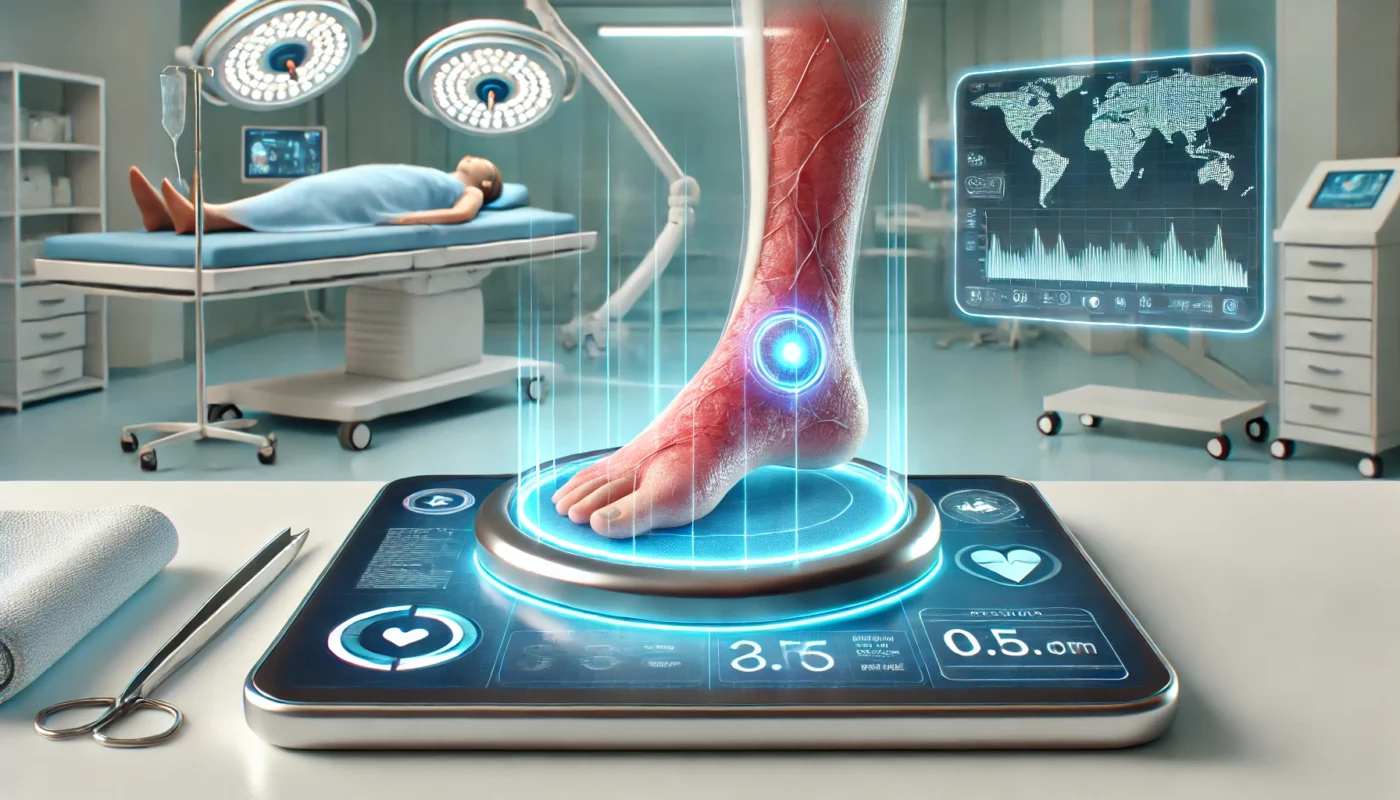Chronic wounds are those that fail to heal in a predictable manner, often lingering for weeks or even months. Common examples include diabetic ulcers, pressure ulcers, and venous ulcers. These wounds can be debilitating, leading to significant discomfort and increased risk of infection. The complexity of chronic wounds necessitates a multifaceted approach to treatment, combining traditional and alternative therapies.
You may also like: Home Remedies: Fight Cut Infections Naturally
Types of Chronic Wounds
Diabetic ulcers are a prevalent type of chronic wound commonly seen in patients with diabetes. These ulcers often develop due to neuropathy and peripheral vascular disease, which impair normal wound healing processes. Managing blood sugar levels and protecting the feet from injury are crucial components of preventing these ulcers.
Pressure ulcers, also known as bedsores, occur due to prolonged pressure on the skin, often affecting individuals with limited mobility. These ulcers require diligent attention to repositioning and the use of specialized mattresses or cushions to alleviate pressure and prevent further skin breakdown.
Venous ulcers result from chronic venous insufficiency, where damaged veins lead to poor circulation and skin breakdown, particularly in the lower extremities. Compression therapy is a cornerstone of treatment, helping to improve blood flow and reduce swelling.
Challenges in Healing
The healing of chronic wounds is often hindered by underlying conditions such as poor circulation, infection, and systemic diseases. Each of these factors can significantly impede the body’s natural healing processes, requiring targeted interventions to overcome these barriers.
Infection is a major complication in chronic wounds, as it can exacerbate tissue damage and prolong healing times. Proper wound care practices, including the use of antiseptic solutions and regular monitoring, are vital in preventing and managing infections.
Systemic diseases like diabetes and autoimmune disorders can further complicate wound healing. These conditions may weaken the immune system’s response, necessitating careful management of the underlying disease to support effective wound care.
Impact on Quality of Life
Chronic wounds can significantly impact a patient’s quality of life, affecting physical, emotional, and social well-being. Persistent pain and discomfort can lead to reduced mobility, limiting daily activities and independence.
The social implications of chronic wounds are profound, as individuals may experience embarrassment or self-consciousness due to visible wounds or odor. This can lead to social isolation and decreased participation in community or social activities.
Emotional health is also a concern, with many patients experiencing feelings of frustration, anxiety, or depression due to the prolonged nature of their condition. Comprehensive wound care should include psychological support to address these emotional challenges and enhance overall well-being.

Advances in Skin Healing Medicine
The field of skin healing has seen remarkable progress, with numerous medications and therapies emerging as frontrunners in the quest for rapid wound healing.
Fastest Wound Healing Drugs
One of the most promising areas in wound care is the development of drugs that expedite healing. Some of the fastest wound healing drugs leverage growth factors, which are proteins that stimulate cell proliferation and tissue repair. These drugs can significantly reduce healing times, making them a valuable tool in chronic wound management.
Growth factor therapies work by mimicking the body’s natural healing signals, promoting the formation of new tissue and accelerating the closure of wounds. These treatments are often used in conjunction with other wound care strategies to enhance their efficacy.
Another exciting development is the use of stem cell therapy. By harnessing the regenerative power of stem cells, researchers are exploring new ways to enhance tissue repair. These therapies are still in the experimental stages but show great potential in revolutionizing chronic wound care.
Stem cells can differentiate into various cell types, offering the potential to regenerate damaged tissues. In wound care, they may be used to create new skin cells or promote the formation of new blood vessels, both of which are crucial for healing.
Best Wound Healing Medicine
When it comes to selecting the best wound healing medicine, several options stand out. Topical treatments, such as hydrogel dressings infused with antimicrobial agents, provide a moist environment conducive to healing while preventing infection. Additionally, silver-based dressings are renowned for their antimicrobial properties, making them a staple in wound management.
Hydrogel dressings help maintain optimal moisture levels, which is essential for cellular function and tissue repair. They also provide a barrier against contaminants, reducing the risk of infection in chronic wounds.
Systemic medications, such as anti-inflammatory drugs, also play a crucial role. These drugs reduce inflammation, a common barrier to healing in chronic wounds. Nonsteroidal anti-inflammatory drugs (NSAIDs) are commonly prescribed, but emerging alternatives, like certain herbal supplements, offer holistic benefits with fewer side effects.
In addition to NSAIDs, corticosteroids are sometimes used to manage inflammation, though they must be used cautiously due to potential side effects. Herbal supplements, such as turmeric or ginger, offer natural anti-inflammatory properties and can be an effective adjunct to conventional therapies.
Fast Healing Ointments and Creams
Topical applications remain a cornerstone of wound care, with fast healing ointments and creams leading the charge. Products containing ingredients like aloe vera, honey, and calendula have gained popularity for their natural healing properties. These substances not only promote cell regeneration but also soothe irritated skin, providing dual benefits.
Aloe vera is known for its soothing and anti-inflammatory properties, making it an ideal ingredient for calming irritated skin. Honey, particularly medical-grade Manuka honey, has been shown to possess antimicrobial and healing properties, making it a versatile choice for wound care.
Furthermore, advancements in nanotechnology have led to the development of creams that deliver active ingredients more effectively. These innovations maximize the therapeutic impact of topical treatments, accelerating the healing process.
Nanotechnology allows for the creation of nanoparticles that can penetrate deeper into the skin, ensuring that active ingredients reach their target areas more efficiently. This technology is transforming the way topical treatments are formulated and applied.

Holistic Approaches to Wound Care
While modern medicine provides a wealth of options, holistic approaches offer complementary benefits. By addressing the body’s overall health, these strategies enhance the body’s natural ability to heal.
Nutritional Support for Wound Healing
Nutrition is a critical component of wound healing, with certain nutrients playing pivotal roles. Protein, for instance, is essential for tissue repair, while vitamins C and E support collagen production and protect against oxidative stress. Incorporating a balanced diet rich in these nutrients can significantly enhance healing outcomes.
A diet high in protein provides the building blocks necessary for new tissue formation, which is crucial in closing wounds and restoring skin integrity. Foods rich in vitamins C and E, such as citrus fruits and nuts, help support the body’s natural defense mechanisms.
In addition to vitamins and protein, minerals like zinc and iron are vital for wound healing. Zinc plays a crucial role in cell proliferation and immune function, while iron is necessary for oxygen transport and energy production in healing tissues.
Alternative Therapies
In addition to nutritional support, alternative therapies such as hyperbaric oxygen therapy (HBOT) and low-level laser therapy (LLLT) are gaining traction. HBOT involves breathing pure oxygen in a pressurized environment, which increases oxygen delivery to tissues and promotes healing. LLLT, on the other hand, uses light to stimulate cellular activity, enhancing repair processes.
HBOT is particularly beneficial for chronic wounds that are slow to heal, as it enhances oxygenation of tissues, which is critical for cellular metabolism and repair. This therapy is often used for diabetic foot ulcers and other complex wounds.
LLLT uses specific wavelengths of light to penetrate tissues and stimulate cellular activities, including increased collagen production and improved blood circulation. It is a non-invasive therapy with minimal side effects, making it an attractive option for enhancing wound healing.
Mind-Body Connection
The mind-body connection plays a significant role in wound healing, with stress and emotional health affecting the body’s ability to repair itself. Practices such as meditation, yoga, and mindfulness can help reduce stress and promote a positive healing environment.
Meditation and mindfulness practices focus on calming the mind and reducing stress, which can have a positive impact on the immune system and overall health. These practices can be easily integrated into daily routines to support holistic wound care.
Yoga, with its emphasis on gentle movement and breath control, can improve circulation and flexibility, aiding in wound healing. The practice also encourages relaxation and mental clarity, contributing to a supportive healing environment.

Practical Strategies for Effective Wound Care
For those managing chronic wounds, practical strategies can make a significant difference in healing outcomes. Here are some tips to optimize wound care:
Maintain a Clean Environment
Regularly clean the wound to prevent infection. Use gentle, non-irritating solutions and dressings that maintain a moist healing environment. Proper hygiene practices are essential to remove debris and reduce the risk of bacterial contamination.
Selecting the right cleansing solution is crucial, as harsh chemicals can irritate the wound and delay healing. Saline solution is a popular choice for its gentle yet effective cleaning properties.
Consistently changing dressings at recommended intervals helps maintain a protective barrier and prevents the buildup of exudate, which can harbor bacteria and impede healing.
Monitor for Signs of Infection
Be vigilant for symptoms such as increased redness, warmth, swelling, or discharge. Promptly seek medical attention if infection is suspected. Early detection and intervention are key to preventing complications and ensuring timely healing.
Educating patients and caregivers about the signs of infection empowers them to take proactive measures in wound management. Regular check-ups with healthcare providers can help catch infections early and adjust treatment plans as needed.
Utilizing mobile health technologies, such as apps or telemedicine, can provide continuous monitoring and support for patients with chronic wounds, facilitating timely interventions and personalized care.
Follow a Consistent Treatment Plan
Adhere to prescribed treatments and attend follow-up appointments to ensure optimal healing. Consistency in wound care practices is essential for achieving the best possible outcomes.
Developing a routine that incorporates wound cleaning, dressing changes, and medication administration helps establish a structured approach to care. Setting reminders and creating a care schedule can enhance adherence to treatment plans.
Collaboration with healthcare professionals, including wound care specialists and nutritionists, ensures comprehensive care and allows for adjustments to treatment as needed, addressing any emerging challenges or changes in the wound’s condition.
Incorporate Physical Activity
Engage in moderate exercise to enhance circulation, which supports tissue repair. Consult with a healthcare professional to determine appropriate activities. Physical activity should be tailored to the individual’s capabilities and wound healing stage.
Exercises that promote cardiovascular health, such as walking or swimming, improve blood flow and oxygen delivery to tissues, accelerating the healing process. Strength training can also be beneficial, enhancing muscle tone and overall health.
Avoiding prolonged periods of inactivity is important, as it can lead to complications such as pressure ulcers or decreased mobility. Encouraging regular movement and activity helps maintain physical function and supports wound healing.
Conclusion
Innovative treatments for chronic wound care are continually evolving, offering hope for those affected by these persistent conditions. By staying informed about the latest advancements and integrating holistic approaches, individuals can take proactive steps toward effective wound management. Whether through cutting-edge medications, natural remedies, or lifestyle modifications, a comprehensive approach to wound care can significantly improve healing outcomes and quality of life. The future of wound care is promising, with ongoing research and development paving the way for more effective and personalized treatment strategies.
Further Reading:
5 Treatments That Enhance Wound Healing
New Treatment to Help Wounds Heal Faster
HBOT, LLLT, wound healing, chronic wounds, diabetic foot ulcers, mind-body connection, meditation, yoga, mindfulness, wound care strategies, infection prevention, treatment plan, physical activity, holistic health, innovative treatments, healthcare technology, patient education, telemedicine, circulation, tissue repair
Important Note: The information contained in this article is for general informational purposes only, and should not be construed as health or medical advice, nor is it intended to diagnose, prevent, treat, or cure any disease or health condition. Before embarking on any diet, fitness regimen, or program of nutritional supplementation, it is advisable to consult your healthcare professional in order to determine its safety and probable efficacy in terms of your individual state of health.
Regarding Nutritional Supplements Or Other Non-Prescription Health Products: If any nutritional supplements or other non-prescription health products are mentioned in the foregoing article, any claims or statements made about them have not been evaluated by the U.S. Food and Drug Administration, and such nutritional supplements or other health products are not intended to diagnose, treat, cure, or prevent any disease.

